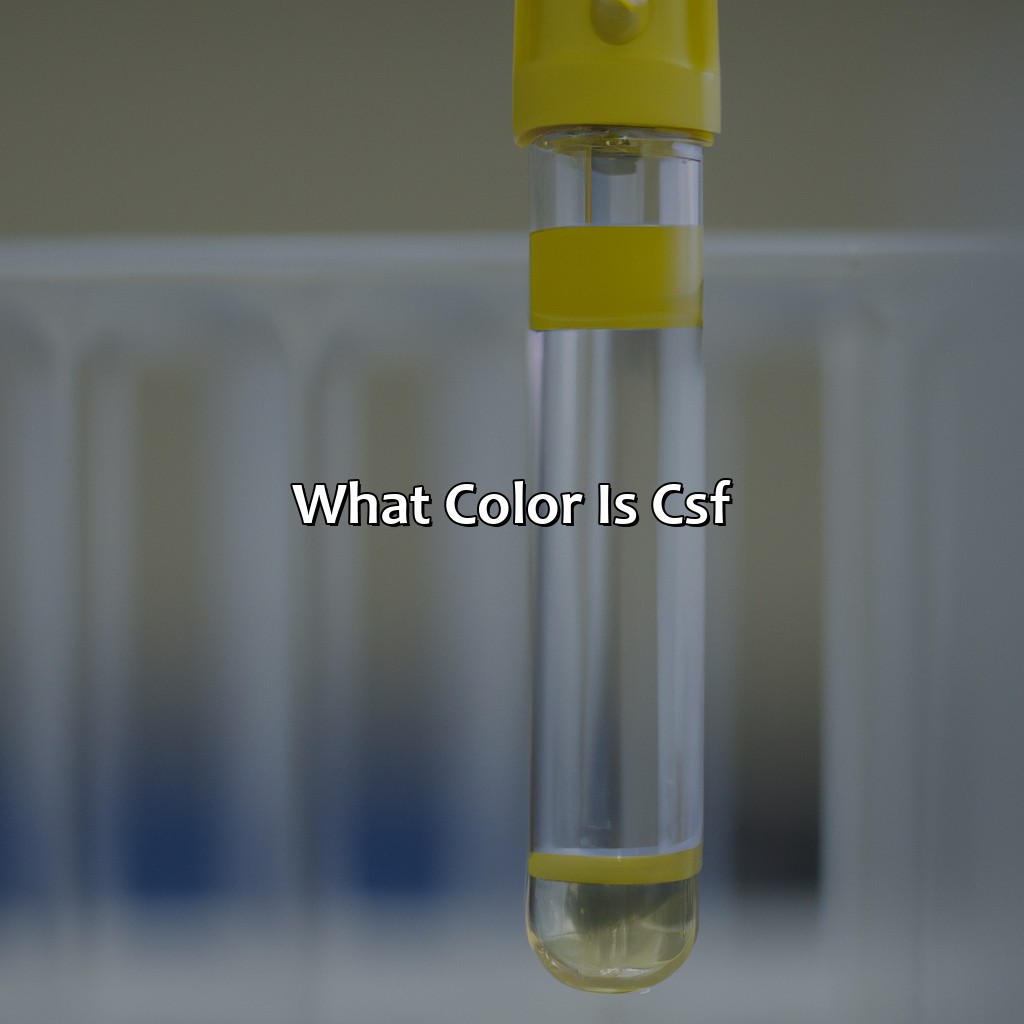Key Takeaway:
- Normal CSF is clear and colorless: Clear CSF indicates absence of infection, bleeding, and abnormal cells. The color of CSF may vary depending on the presence of certain substances such as red blood cells and bilirubin.
- Xanthochromia may indicate subarachnoid hemorrhage: Yellowish or pink-tinged CSF may indicate presence of blood due to subarachnoid hemorrhage. CSF examination can detect presence of abnormal cells and proteins that may indicate underlying conditions.
- Abnormal CSF color can result from various conditions: Cloudy or bloody CSF may be a sign of infections, brain infection, neurological disorders, or spinal cord injury. Treatment of abnormal CSF depends on underlying conditions.
What is CSF?

Photo Credits: colorscombo.com by Dennis Harris
CSF, short for cerebral spinal fluid, is a clear liquid that surrounds the brain and spinal cord, providing protection and cushioning against impact. It is produced in the ventricles of the brain by the choroid plexus and circulates through the subarachnoid space. CSF also helps to remove waste products from the brain and maintains a stable environment by regulating electrolytes. Despite being a liquid, CSF plays a crucial role in the functioning of the brain, and any imbalance can lead to neurological disorders. It is essential to understand the composition and functions of CSF to diagnose and treat such conditions.
The color of CSF can vary depending on certain medical conditions and the presence of blood or other substances. However, in a typical healthy individual, the color of CSF is clear and transparent. The liquid is slightly alkaline and contains glucose, proteins, and various ions, such as sodium and potassium. The blood-brain barrier helps to maintain the composition of CSF by regulating the entry of substances from the bloodstream. The color of CSF is not the only indicator of its health, and a medical examination can provide a comprehensive assessment of its composition and functioning.
Moreover, the presence of abnormal cells or increased pressure can result in changes in the color and consistency of CSF. These changes can indicate several neurological disorders, such as meningitis and multiple sclerosis. It is crucial to understand the symptoms associated with such conditions and seek medical attention if required. A medical professional can perform a lumbar puncture to examine the composition of CSF and determine the underlying cause of symptoms.
The Normal Color of CSF
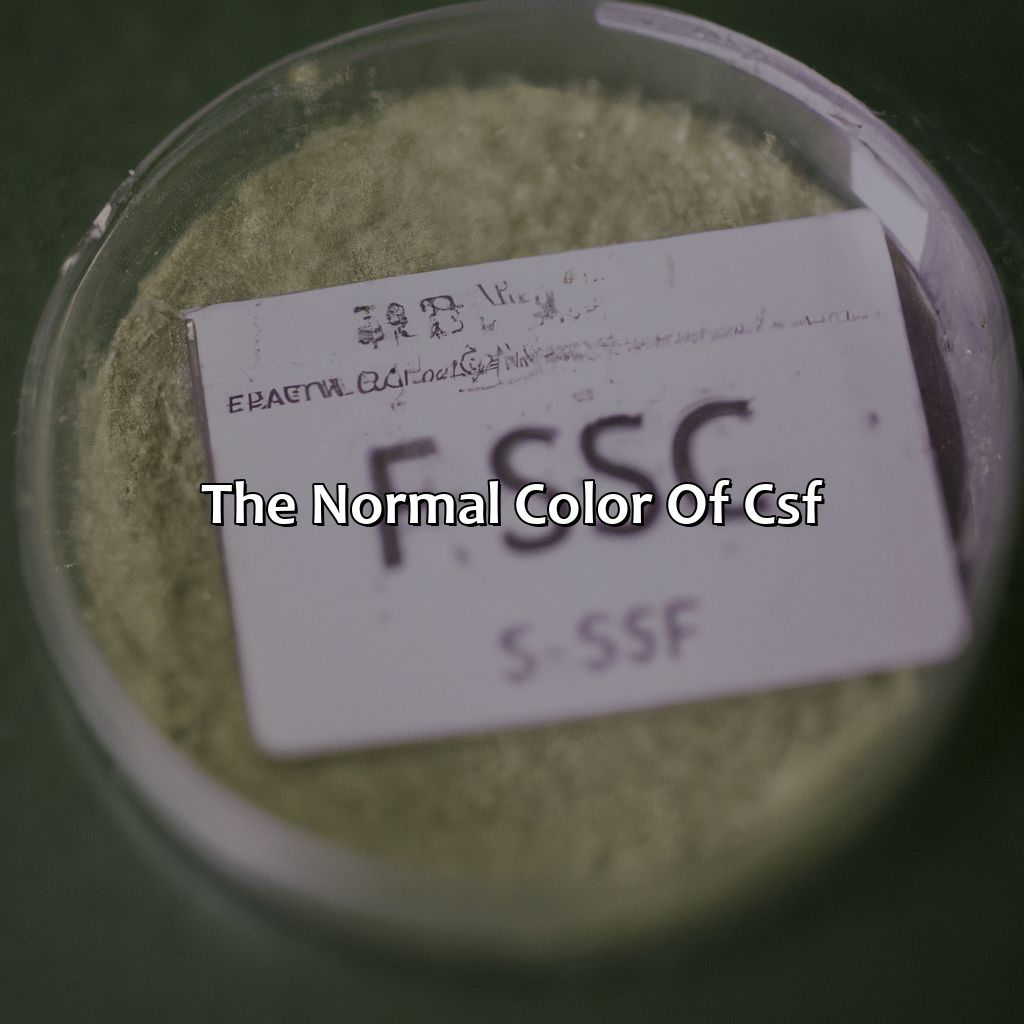
Photo Credits: colorscombo.com by Jack Anderson
Glimpse your clear CSF to check the usual color. This test will tell you the protein and glucose levels in your CSF. It can also detect xanthochromia, which is an abnormal yellow shade caused by red blood cells. In this section, we will discuss two sub-sections – Clear CSF and Xanthochromia.
Clear CSF
The cerebrospinal fluid (CSF) is a clear, colorless liquid that surrounds the brain and spinal cord. The color of CSF is an essential indicator of its contents. Clear CSF indicates normal protein levels and glucose levels in CSF. Its transparency means there are no abnormal cells or debris present.
Furthermore, changes in the concentrations of protein and glucose levels can alter the condition of the fluid, leading to CSF abnormalities and discoloration. Since clear CSF signifies a healthy brain and spinal cord, it is necessary to maintain it.
Moreover, clear CSF provides optimal conditions for efficient communication between neurons as it contains nutrients that support their function. The lack of pigmentation allows light to pass through and reach the body’s macrophages to dispose of cellular debris.
A patient underwent symptoms like vomiting, severe headache, loss of balance and coordination all at once which did not allow him to perform daily activities precisely. Doctors examined his cerebrospinal fluid (CSF), resulting from a lumbar puncture (LP). The results showed xanthochromia in the sample due to injury or trauma based on blood appearance amongst other factors causing discoloration.
When it comes to CSF abnormalities, a high red blood cell count can indicate a serious condition like subarachnoid hemorrhage – which is no laughing matter.
Xanthochromia
In addition to subarachnoid hemorrhage, xanthochromia may also occur due to infections or inflammation in the central nervous system. Such CSF abnormalities can be detected through laboratory analysis that includes spectrophotometry and red blood cell count.
To rule out non-hemorrhagic causes of xanthochromia, physicians may need to perform additional tests such as CT scans or lumbar punctures. Proper diagnosis of underlying conditions causing discolored CSF is critical for appropriate treatment options.
Treatment regimes for xanthechromiaed-CFS focuses on addressing the underlying cause of its formation, such as treating infections or managing subarachnoid hemorrhages. Accurate and efficient diagnosis is essential in achieving positive therapeutic outcomes.
From bacterial meningitis to spinal cord injuries, the causes of discolored CSF are not for the faint of heart.
The Causes of Discolored CSF
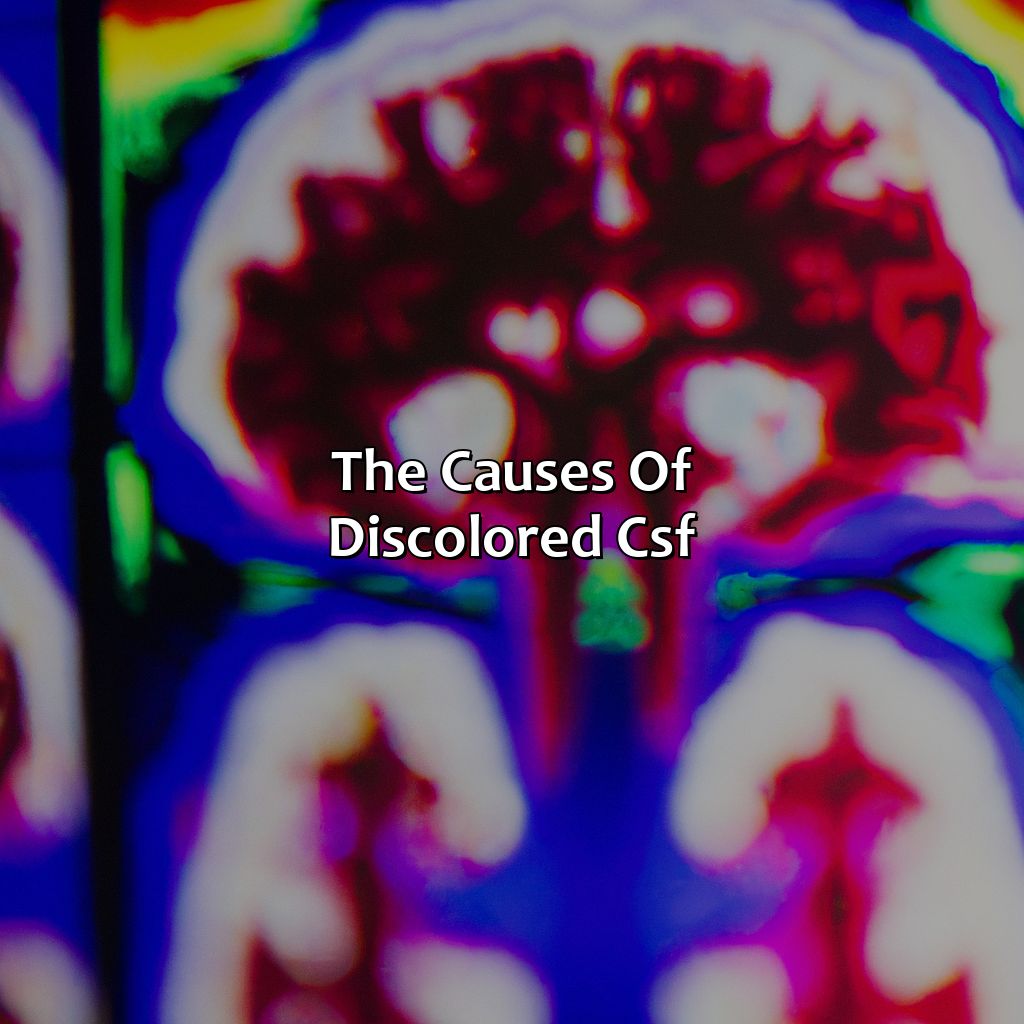
Photo Credits: colorscombo.com by Charles Smith
To work out the source of discolored cerebrospinal fluid (CSF), like cloudy or bloody CSF, you must check out the reasons that cause it. There can be many things that lead to discolored CSF. These include:
- infection like meningitis, brain infection, and neurological disorders;
- blood in CSF such as red blood cell count and subarachnoid hemorrhage;
- trauma or injury like CSF leakage and spinal cord injury;
- and abnormal cells that need to be tested and interpreted with CSF.
Infection
Infections causing changes in color of CSF can occur due to various reasons. Such infections may also lead to an increase in white blood cell count, indicating possible meningitis or brain infection. Other neurological disorders may also be responsible for discoloration of CSF due to inflammatory events triggered by the pathological cascade. Early diagnosis and treatment are crucial in managing such conditions, which can lead to severe complications if left untreated.
To effectively treat discolored CSF caused by infections, prompt antibiotic therapy is recommended along with supportive care. Meningitis due to bacterial causes often requires intravenous antibiotics while viral meningitis treatment may not warrant the use of antibiotics altogether. Treatment should also focus on addressing underlying factors that may have contributed to an infection’s development. Regular follow-ups with a healthcare provider can keep track of any complications and adjust treatments as needed.
Pro Tip: Timely and accurate diagnosis of abnormalities in CSF requires expertise and experience from healthcare providers. A thorough understanding of associated symptoms, clinical presentation, detailed history taking, laboratory investigations (including special tests), imaging studies, and collaborative approaches with specialists can be vital in achieving the desired outcome for patients with abnormal results in their CSF testing.
Looks like someone spilled their Merlot in the spinal fluid: a guide to bloody CSF and its causes.
Blood in CSF
Blood in cerebrospinal fluid (CSF) is a worrying sign, indicating an underlying problem. The presence of bloody CSF can be due to many factors, including trauma, infection, tumors and subarachnoid hemorrhage.
Hemorrhages are one of the common causes of blood-stained CSF. A significant traumatic injury to the brain or spinal cord may disrupt blood vessels that can cause bleeding into the CSF. Hemorrhage leads to a substantial increase in the number of red blood cells (RBCs) in the sample, leading to hemorrhagic fluids.
The diagnosis for bloody cerebrospinal fluid starts with collecting an appropriate volume of CSF from patients with suspected neurologic disease. A laboratory examination for glucose concentration and bacterial analysis may further help to provide a possible diagnosis. In cases of subarachnoid hemorrhage, a lumbar puncture is essential if initial imaging tests were negative.
Treatment strategies will depend on identifying or removing any underlying conditions cited as causing the bloody cerebrospinal fluid samples. These treatments could include emergency surgery for hemorrhages or prescription antibiotics for infections; additionally, proper management involves rigorous monitoring of timely follow-ups.
When it comes to CSF leakage and spinal cord injury, the only thing worse than the injury itself is the discolored CSF that follows.
Trauma or Injury
CSF discoloration can also occur due to spinal cord injury or CSF leakage. The abnormal composition of CSF caused by trauma or injury can lead to a change in its color, indicating an underlying condition. Spinal cord injury can cause red blood cells to enter the CSF, leading to xanthochromia. CSF leakage can also cause the fluid to become cloudy or yellowish in color.
It is essential to note that spinal cord injury and CSF leakage may not be the only causes of discolored CSF. Other factors such as an infection or abnormal cells may coexist and cause further complications. Therefore, a thorough analysis of the patient’s medical history is critical before initiating treatment.
A case was reported where a patient with spinal cord injury developed discolored CSF due to bleeding in the subarachnoid space. This led to impaired neurological function, and timely diagnosis and intervention were required for recovery.
Therefore, it is crucial to monitor any changes in CSF appearance carefully, especially after trauma or injury, and seek medical attention immediately if necessary.
When CSF reveals abnormal cells, it’s time for diagnostic tests and interpretation to determine the underlying condition.
Presence of Abnormal Cells
Aberrant cells in cerebrospinal fluid (CSF) refer to any atypical cell presence that indicates an underlying medical condition. This usually includes the growth of abnormal or cancerous cells known as neoplastic meningitis, a significant contributor to increased morbidity among patients with cancer. In patients with acute meningitis, cerebral hemorrhage, cerebral infections such as tuberculosis meningitis and fungal meningitis, or multiple sclerosis (MS), abnormalities in CSF findings may appear due to the production of antibodies against autoantigens.
These abnormal CSF findings can only be diagnosed through proper diagnostic tests and interpretation of CSF analysis reports. A comprehensive approach is required since CSF interpretations are subjective and must consider a wide range of test results from both the blood and CSF samples. Alongside typical CSF findings, this testing also considers cellular counts, protein concentration levels, glucose levels and other factors that provide additional clues for diagnosis.
In one documented case study in 2016 where a patient’s symptoms were inconsistent with her given diagnosis, exploratory testing found unusual cell appearances emanating from the pelvic region then spreading over time to other regions of her body. These revelations informed clinicians that she had developed ovarian germ cell tumor associated with N-methyl-D-aspartate receptor antibody encephalitis – an autoimmune disease caused by incorrect antibody regulation. The physicians treated her using cyto-reductive surgery followed by chemotherapy complemented by antibody synthesis to repair lost function.
Cracking open the spine for a lumbar puncture may sound terrifying, but it’s the only way to properly diagnose discolored CSF and determine the right treatment plan.
Diagnosing Discolored CSF
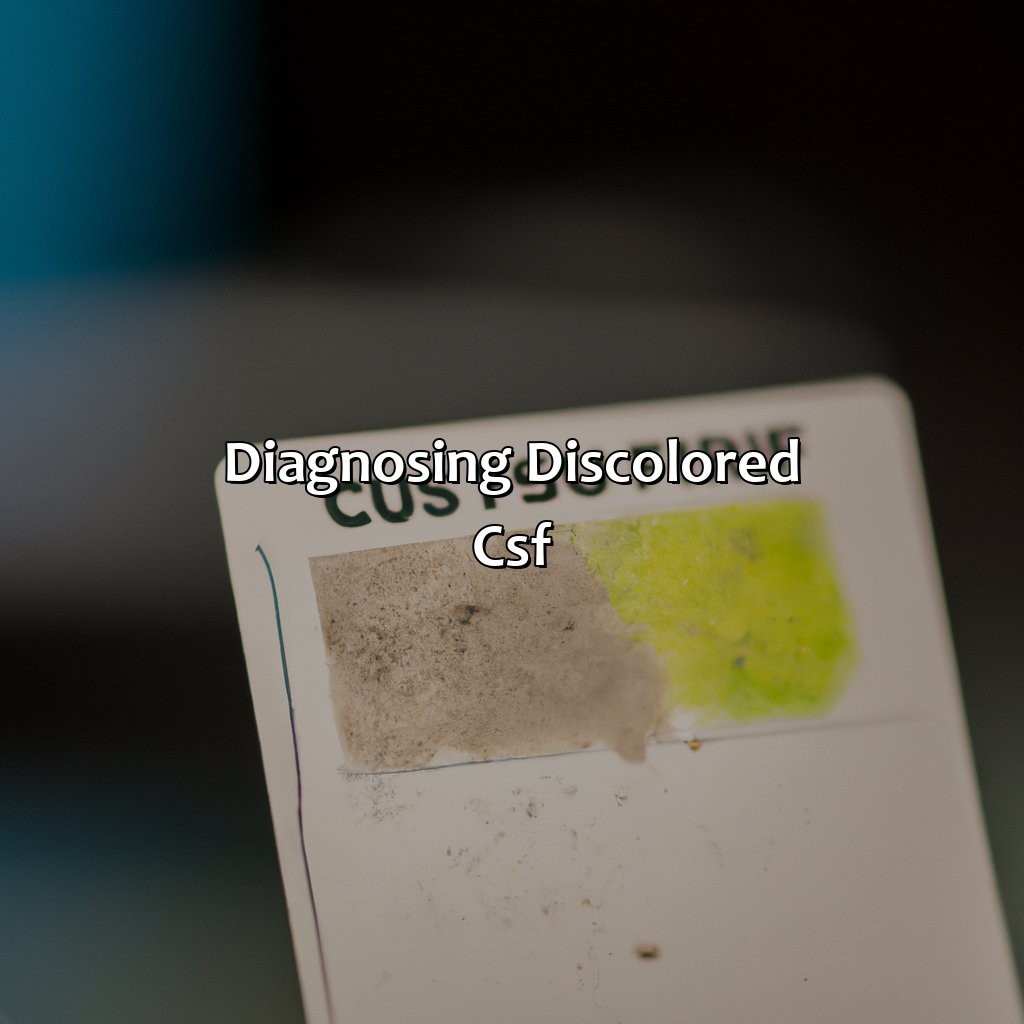
Photo Credits: colorscombo.com by Kenneth Sanchez
You need know-how to diagnose discolored CSF with a lumbar puncture. It includes two steps. Firstly, analyzing the CSF abnormalities. That includes counting red and white blood cells, protein and glucose levels. Secondly, the doctor will interpret the results to diagnose any CSF abnormalities. They use various diagnostic tests for this purpose.
Collection of CSF Sample
A 5-step guide for collecting a CSF sample involves:
- Sterilization: Sterilize skin around puncture site and gear required for insertion.
- Positioning: The patient lies on their side or sits and the examiner locates the puncture site.
- Puncture & fluid collection: The doctor inserts the needle into appropriate puncture sites, collecting approximately 10-20 ml of CSF fluid.
- Removing Needle: After completion, slowly withdraw the needle.
- Compression & Dressing: Apply pressure to the site for three to five minutes to avoid leakage, followed by securing with an adhesive dressing.
During CSF analysis, several factors are taken into account before providing diagnostic results. These include; Color, Appearance, Protein level, Glucose level and Cell counts.
In one instance, during a regular medical check-up at an outpatient clinic, a young woman experienced severe headaches accompanied by vomiting. Prompt referral was made for lumbar puncture where brownish-green CSF fluid was extracted. Further analysis concluded that enterococcal meningitis caused by bacteria had generated the discoloration of CSF fluids which then affected her vision and motor coordination leading to intermittent seizures.
Examining a CSF sample involves analyzing its cellular and protein composition to unveil vital clues about the underlying condition.
Examination of CSF Sample
The analysis of CSF sample involves examining its various components and levels to identify any indications of underlying conditions or abnormalities. This process is crucial in diagnosing neurological diseases and disorders.
| Component | Clinical Significance |
| Red Blood Cell Count (RBC) | Elevated RBC count suggests hemorrhage or bleeding in the brain or spinal cord |
| White Blood Cell Count (WBC) | Increased WBC count indicates infection, inflammation or autoimmune disease |
| Protein Levels in CSF | Elevated protein levels suggest infections, tumors, or certain autoimmune diseases |
| Glucose Levels in CSF | Low glucose levels may indicate meningitis, brain abscesses, and other bacterial or viral infections. |
CSF findings are vital indicators of different neurological disorders and help physicians provide effective treatment. The appearance of abnormal cells, increased white blood cell count with elevated protein levels may suggest meningitis, encephalitis while elevated red cell counts signify acute subarachnoid hemorrhage.
To avoid overlooking signs of dangerous conditions early on, it’s essential to seek medical attention immediately upon noticing any symptoms indicating a need for testing CSF such as severe headaches, neck stiffness, nausea/vomiting with fever that aren’t resolving. Delaying diagnosis could lead to life-threatening consequences. Unpacking the results: how to decipher CSF abnormalities and navigate diagnostic tests like a pro.
Interpretation of Results
The evaluation of CSF abnormalities involves the interpretation of diagnostic tests conducted on the collected sample. The results obtained from examination of CSF can help determine underlying medical conditions that may require immediate treatment.
The following table showcases the possible interpretations of abnormal CSF results based on various factors that cause discoloration:
| Factors | Possible Interpretations |
|---|---|
| Xanthochromia | Blood in CSF |
| Cloudy Appearance | Increased proteins, infection, inflammation |
| Elevated Red Blood Cells | Hemorrhage, infection |
| Elevated White Blood Cells | Infection or inflammation, cancer |
| Abnormal Glucose Levels | Infection, meningitis |
| Elevated Protein Level | Infection, inflammation |
It is important to note that interpretation of results requires professional expertise and should not be taken lightly. Additional diagnostic tests may also be required to accurately diagnose the condition.
Pro Tip: Consult a licensed healthcare professional for accurate diagnosis and treatment options in case of abnormal CSF results.
Fixing abnormal CSF is like finding a needle in a haystack, except the haystack is your central nervous system and the needle is the underlying cause.
Treatment of Abnormal CSF
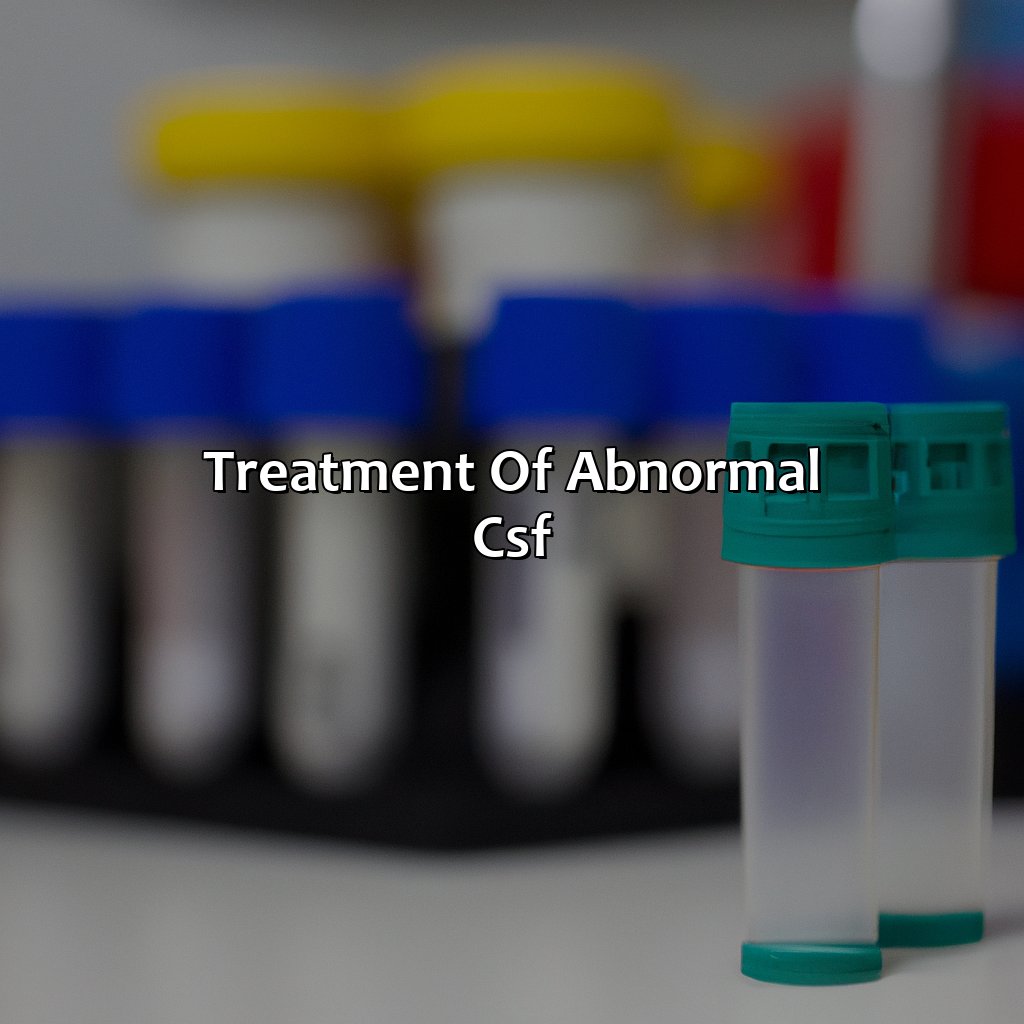
Photo Credits: colorscombo.com by Stephen Wright
Treating abnormal, colorless CSF is key. Specific techniques can be used to cure meningitis, brain infections, and neurological disorders. For those with neurodegenerative diseases, certain proteins can be beneficial. These include: central nervous system or brain-derived neurotrophic factor, neuron-specific enolase, S100 beta, tau protein, and amyloid beta protein. Addressing underlying conditions is the way to go.
Treating Infections
Antimicrobial therapy is a common approach in treating meningitis or other brain infections. Administering an appropriate antibiotic is essential, depending on the specific neurologic disorder that affected the patient. Combination therapy is typically used when there is high resistance to antibiotics. In severe cases, corticosteroids are utilized to decrease inflammation and pressure inside the skull, which can alleviate long-term neurological deficits.
Interestingly, according to a study published in the Journal of Antimicrobial Chemotherapy, long-term antibiotic administration can produce spontaneous bacterial meningitis caused by resistant Acinetobacter baumannii complex strains. With this information, healthcare providers must balance antimicrobial use with potential bacterial resistance.
Furthermore, clinical judgment dictates medication selection and dosing based on blood-brain barrier penetration ability, effectiveness against drug-resistant bacteria, and toxicity prevention for vulnerable populations like neonates or people with comorbidities. It’s imperative for physicians to stay vigilant of possible drug interactions that could complicate treatment plans.
Treating the underlying conditions of abnormal CSF goes beyond just addressing infections and may involve targeting neurodegenerative diseases through proteins such as S100 beta, tau protein, and amyloid beta protein.
Addressing Underlying Conditions
Addressing underlying conditions involves treating the root cause that led to abnormal CSF. This is crucial because if left untreated, it could lead to further complications such as neurodegenerative diseases. Tests such as neuron-specific enolase, s100 beta, tau protein, and amyloid beta protein can be done to assess the severity of the condition.
Once the underlying cause has been identified, treatment options vary depending on the diagnosis. For instance, infections can be treated with antibiotics or antifungal medications. If there is an injury or trauma to the brain or spinal cord, surgery may be necessary. Presence of abnormal cells may require further investigations and management by a specialist or neurologist.
Also considered is monitoring and tracking any changes in symptoms over time through periodic testing to ensure that treatments are effective. In addition to medical treatments, it is important for patients with neurological conditions to engage in cognitive and behavioral therapies as well as physical activities such as exercise that support brain health particularly stimulating brain-derived neurotrophic factor production.
Overall, addressing underlying conditions requires a comprehensive approach with input from specialists in various areas including neurology, infectious disease management, oncology and surgery depending on diagnosis specifics.
Five Facts About the Color of Cerebrospinal Fluid (CSF):
- ✅ The color of CSF is typically clear and colorless. (Source: MedlinePlus)
- ✅ However, certain medical conditions can cause the color of CSF to change, such as meningitis, which can cause a cloudy or yellow color. (Source: Healthline)
- ✅ Blood in the CSF can cause it to appear red or pink. (Source: Mayo Clinic)
- ✅ The presence of bilirubin, a pigment produced by the liver, can cause CSF to appear yellow or green. (Source: Medscape)
- ✅ In rare cases, CSF can also appear brown or black due to the presence of melanin or other pigments. (Source: Medscape)
FAQs about What Color Is Csf
What color is CSF?
Cerebrospinal fluid (CSF) is typically clear and colorless. However, it can sometimes appear slightly yellow or pinkish due to the presence of blood.
What causes CSF to change color?
A change in CSF color can indicate a variety of conditions, including bleeding in the brain or spinal cord, infection, or the presence of certain substances or chemicals. It is important to seek medical attention if there is a noticeable change in the color of your CSF.
How is the color of CSF tested?
The color of CSF is typically observed during a lumbar puncture, also known as a spinal tap. During this procedure, a healthcare provider will insert a needle into the lower back to collect a sample of CSF for testing. The color of the fluid can give important insights into a person’s health status.
Can a person’s diet affect the color of their CSF?
There is no evidence to suggest that diet can impact the color of CSF. However, certain medications or substances can cause changes in the color of the fluid.
Is it normal for CSF to have a slight yellow tint?
A slight yellowish tint in CSF can be normal and is often due to the presence of small amounts of bilirubin, a natural byproduct of the breakdown of red blood cells. However, if the yellow tint is more pronounced or accompanied by other symptoms, medical attention may be necessary.
What should I do if I notice a change in the color of my CSF?
If you notice a change in the color of your CSF, it is important to seek medical attention right away. Your healthcare provider can perform tests to determine the underlying cause of the change in color and recommend appropriate treatment.
